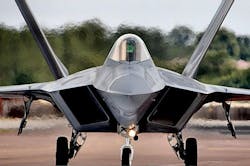How Russia or China could use counter-stealth IRST to shoot down America's stealth fighters
The Military & Aerospace Electronics take:
16 Jan. 2019 -- With Boeing and the U.S. Navy explaining in detail how a combination of longwave IRST combined with high-speed multi-ship data networking and advanced sensor fusion algorithms can generate a weapons quality track on enemy stealth fighters, it is only a matter of time before adversaries such as Russia and China develop similar capabilities.
Moscow and Beijing have most of the elements needed to develop and field counter-stealth technologies similar to that demonstrated by the Navy and Boeing during Fleet Exercise 2017 onboard a pair of modified F/A-18E/F Super Hornets using a combination of the powerful DTP-N processor, TTNT high-speed IP-based data-network and the longwave Block II IRST pod.
The Navy will be fielding its new counter-stealth capabilities in the coming years as the Block III Super Hornet enters service in 2022. Given that the Russians and the Chinese possess the individual elements of all the required technologies to replicate the U.S. Navy’s capabilities, it is only a matter of time before Moscow and Beijing start to field similar counter-stealth abilities.
John Keller, chief editor
Military & Aerospace Electronics
Ready to make a purchase? Search the Military & Aerospace Electronics Buyer's Guide for companies, new products, press releases, and videos
